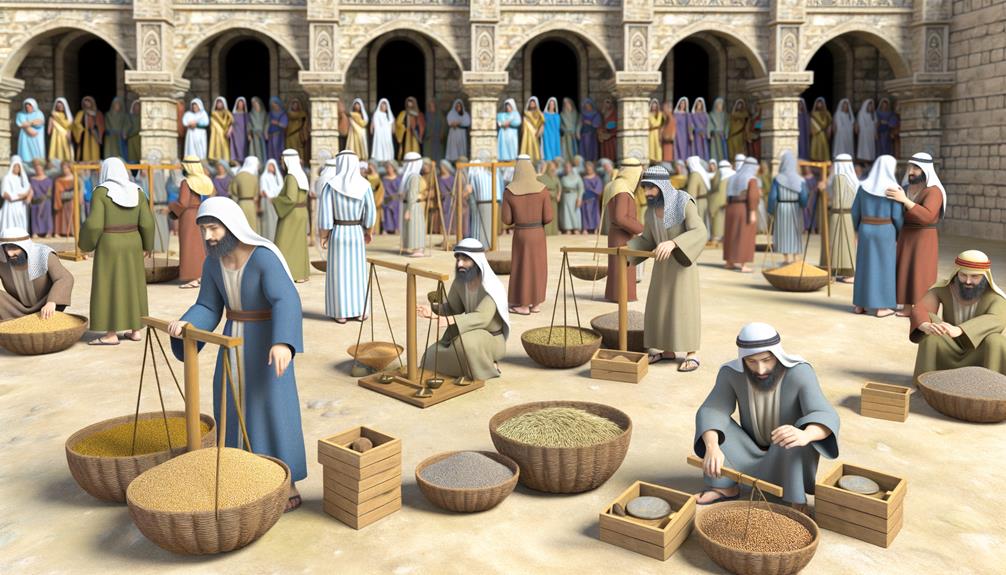Efa Meaning in the Bible: Measurement and Justice
In the Bible, ‘efa’ denotes an ancient Hebrew unit of dry measure, approximately equal to 22 liters or 5.8 gallons. This measure was essential for agricultural trade, ensuring fair and consistent transactions.
Scriptural references, such as Leviticus 19:36, emphasize honest dealings, while Ezekiel 45:11 standardizes it for temple offerings. Additionally, its symbolic importance reflects themes of justice and divine provision, as seen in Ruth 3:15 and Amos 8:5.
Understanding ‘efa’ sheds light on the sophisticated economic practices and ethical teachings of ancient Israel, revealing deeper insights into biblical society and commerce.

Efa Meaning in the Bible: Symbolism and Use of the Ephah Unit in Scripture
| Aspect | Biblical Interpretation | Key Verses |
|---|---|---|
| Definition | Ephah (efa) is a dry measure, approx. 22 liters or 0.6 bushels | Exodus 16:36 |
| Used in Offerings | Measurement for grain offerings to God | Leviticus 5:11, Numbers 15:4 |
| Symbol of Fair Trade | Used in honest commerce, symbolizing fairness | Amos 8:5, Leviticus 19:36 |
| Provision and Sustenance | Represents God’s provision through food and grain | Ruth 2:17 |
| Spiritual Insight | Calls for just measures, reflecting God’s righteousness | Proverbs 11:1 |
Definition and Origin

The term ‘efa‘ in the Bible refers to an ancient Hebrew unit of dry measure, roughly equivalent to 22 liters or about 5.8 gallons. Its origin can be traced back to the agrarian practices and economic systems of ancient Israel.
This measure was integral to the everyday life of the Israelites, facilitating the exchange and quantification of essential agricultural commodities such as grain.
The use of standardized measurements like the efa underscores the sophistication of ancient Israel’s economic infrastructure, ensuring fairness and consistency in trade.
The term also reflects the broader cultural and societal norms of the period, where precise measurements were vital for sustaining the community’s agricultural productivity and ensuring equitable resource distribution.
Scriptural References

Notably, scriptural references to the ‘efa’ are abundant within the Old Covenant, illustrating its importance in religious, economic, and social contexts. The term ‘efa’ frequently appears in the context of measure and trade, underpinning the significance of just and fair dealings. For instance, in Leviticus 19:36, the use of accurate weights and measures, including the ‘efa’, is mandated to guarantee honesty.
Key scriptural references include:
- Ezekiel 45:11 – Establishing the ‘efa’ as a standard measure in temple offerings.
- Exodus 16:36 – Defining an ‘efa’ as a tenth of a homer, contextualizing its volume.
- Amos 8:5 – Highlighting the misuse of the ‘efa’ in fraudulent business practices.
These references underscore the ‘efa’s’ integral role in maintaining societal integrity.
Measurement and Conversion

Understanding the precise measurement and conversion of the ‘efa’ is essential for appreciating its role and application in biblical times. The ‘efa,’ an ancient Hebrew unit of dry measure, approximates to about 22 liters or 5.8 gallons. It is equivalent to one-tenth of a ‘homer,’ another biblical unit.
This measurement was vital in various transactions, particularly in the trade and distribution of grains and other staple commodities, thereby ensuring standardized and equitable exchanges.
Converting the ‘efa’ into modern measurements helps us contextualize biblical narratives within contemporary understanding. Sources such as archaeological findings and historical texts have aided scholars in pinpointing these conversions, providing a clearer insight into the economic and daily life of ancient civilizations as documented in the Bible.
Symbolic Significance

Beyond its practical use in trade and measurement, the ‘efa’ also carries profound symbolic significance in biblical literature, often representing themes of justice, provision, and divine abundance.
The use of the ‘efa’ in various scriptural contexts illuminates deeper spiritual meanings:
- Justice: In Leviticus 19:36, the call for honest measurements underscores the importance of fairness and integrity in societal dealings.
- Provision: The story of Ruth and Boaz in Ruth 3:15, where an ‘efa’ of barley symbolizes God’s provision and care for the needy.
- Divine Abundance: Ezekiel 45:11 uses the ‘efa’ to illustrate the abundance and generosity of divine blessings, emphasizing equity and fairness.
These instances collectively highlight the ‘efa’ as a multifaceted symbol deeply woven into the biblical narrative.
Practical Applications

In practical terms, the ‘efa’ served as a significant unit of measurement in ancient Israel, facilitating trade, commerce, and daily sustenance within the society. This standardized measure guaranteed fair transactions, aiding in the regulation of grain distribution, a staple in the diet. The ‘efa’ also played a key role in agricultural planning and religious offerings, underscoring its multifaceted utility.
| Aspect | Function | Significance |
|---|---|---|
| Trade | Standardized transactions | Guaranteed fairness and consistency |
| Commerce | Exchange of goods | Promoted economic stability |
| Daily Sustenance | Measurement of grain | essential for nutrition and food security |
| Agricultural Planning | Quantifying harvests | Assisted in resource management |
| Religious Offerings | Determining offerings | Maintained ritualistic accuracy |
Understanding the ‘efa’ is important for comprehending the socio-economic dynamics of ancient Israel.
Conclusion
In summation, the term ‘efa’ in the Bible serves as both a unit of measurement and a symbol with rich theological implications.
While it quantifies material goods, its presence in scripture underscores themes of divine provision and justice.
As the adage goes, ‘Biblical truths are often hidden in plain sight,’ and understanding the multifaceted role of ‘efa’ reveals deeper layers of biblical wisdom and context, reinforcing its enduring significance in scriptural study.






